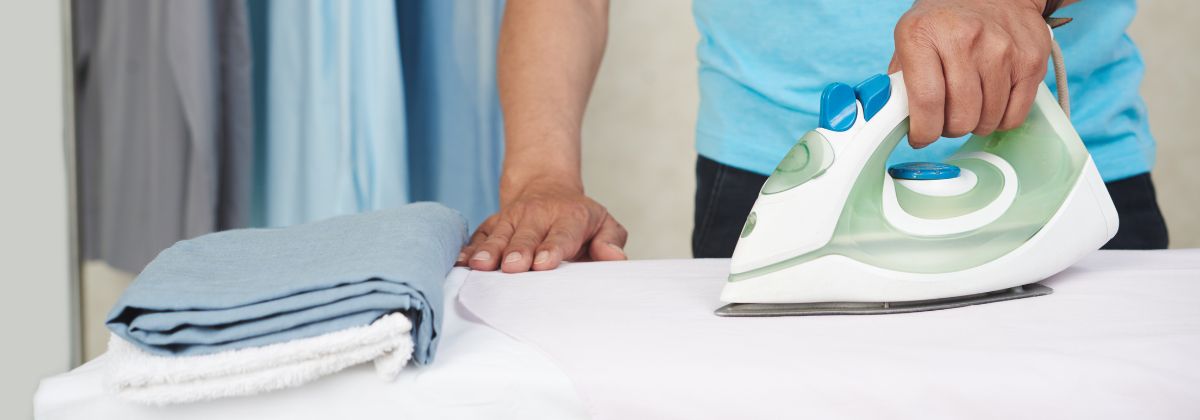08 Sep Reviving Old Clothes: How Ironing Can Make Worn-out Items Look New
In today’s fast-paced world of fashion, it’s all too easy to discard old clothes and replace them with new ones. However, there’s a sustainable and cost-effective way to give your worn-out wardrobe a fresh lease on life: ironing. In this blog post, we’ll explore the art of reviving old clothes with a hot iron and discover how this simple technique can transform tired garments into fashion-forward pieces. Let’s delve into the world of creases and wrinkles to learn how to make your clothes look new again.
Why Reviving Old Clothes?
Before we dive into the ironing techniques, it’s crucial to understand why reviving old clothes is essential. First and foremost, it’s an eco-friendly practice that reduces the environmental impact of fashion consumption. The fashion industry is one of the largest contributors to pollution, so extending the life of your clothing helps combat this problem.
Furthermore, reviving old clothes can save you money. Instead of constantly buying new attire, you can refresh your existing wardrobe and still look stylish. Plus, there’s a sense of satisfaction in breathing new life into an old favourite. Here is the list to show the importance of reviving old clothes:
Environmental Impact:
The fashion industry has a significant environmental footprint, from textile production to transportation and disposal. By reviving old clothes, you actively reduce the demand for new garments, decreasing the industry’s overall environmental impact. This sustainable approach aligns with the growing awareness of climate change and the need for responsible consumer choices.
Click to read more about eco-friendlly ironing tips.
Resource Conservation:
Creating new clothing requires substantial resources, including water, energy, and raw materials. When you choose to revive old clothes, you contribute to resource conservation by extending the lifespan of existing garments. This conservation effort helps mitigate the overuse of finite resources and minimizes pollution associated with production.
Reduction of Textile Waste:
The fashion industry generates an alarming amount of textile waste each year. By keeping your old clothes in circulation, you play a part in reducing this waste stream. Textile waste often ends up in landfills, where it can take years to decompose, releasing harmful chemicals in the process. Reviving old clothes prevents them from becoming part of this problematic waste cycle.
Personal Style and Sentimental Value:
Old clothes often hold sentimental value. They might remind you of special occasions, adventures, or important moments in your life. Reviving these garments not only extends their lifespan but also allows you to continue showcasing your style and preserving memories.
Cost-Efficiency:
In an era of rising costs, reviving old clothes can significantly impact your budget. Instead of frequent shopping sprees, you can allocate your resources elsewhere while still maintaining a fashionable and varied wardrobe. This approach to dressing not only saves money but also encourages a more mindful and intentional approach to consumption.
Unique Fashion Statements:
Revived clothing can often become unique fashion statements. As fashion trends come and go, you may find that some of your old pieces have a timeless charm or a distinct style that sets you apart from the crowd. Your revived clothes can reflect your individuality and creativity in ways that mass-produced garments often cannot.
The Magic of Ironing: How Ironing Makes Clothes Look New
Ironing is more than just a chore; it’s a skill that can work wonders on your clothes. Here’s how it can make worn-out items look new:
- Wrinkle Removal: Ironing effectively removes wrinkles and creases from your clothes, instantly making them appear neater and more polished.
- Fabric Restoration: Over time, some fabrics can lose their shape and structure. A hot iron can help restore the original form of the garment, making it look rejuvenated.
- Professional Finish: Ironing provides a crisp and professional finish, making even casual clothes suitable for more formal occasions.
Ironing Tips for Reviving Old Clothes:
Now that you understand the benefits, let’s explore some ironing tips for reviving old clothes:
- Sort Your Clothes: Group your clothes by fabric type and temperature settings to avoid damaging delicate materials.
- Use Steam: Steam irons are excellent for removing stubborn wrinkles. Invest in a quality steam iron for the best results.
- Press, Don’t Rub: Press the iron gently onto the fabric instead of rubbing it back and forth. This prevents stretching or damaging the material.
- Pay Attention to Collars and Cuffs: These areas tend to wrinkle the most. Pay extra attention to them to achieve a polished look.
- Hang Immediately: After ironing, hang your clothes immediately to prevent new wrinkles from forming.
Choosing the Right Iron:
Before you embark on your journey to revive your old clothes, it’s crucial to have the right tools for the job. Invest in a high-quality iron that offers different temperature settings. This versatility ensures you can safely iron a variety of fabrics, from delicate silks to rugged denim. Additionally, consider a steam iron, as the steam can penetrate fabrics deeply, making the process more effective.
Preparation:
Preparation is key to successful ironing. Start by inspecting the garment for stains or spots, as ironing can set them permanently. Treat any stains with appropriate stain removers before ironing. Next, check for loose buttons, missing threads, or any other damage that needs repairing. Once your garment is stain-free and in good repair, it’s ready for the ironing board.
Ironing Techniques:
Now, let’s explore some essential ironing techniques to maximize the rejuvenating effects on your old clothes:
- Inside Out: For dark-coloured clothing, especially denim or dark cotton, turn the garment inside out before ironing. This prevents any sheen or shine from appearing on the fabric’s surface.
- Steam Boost: When dealing with stubborn wrinkles, utilize the steam boost feature on your iron. Hold the iron just above the fabric, release the steam, and then gently press. This can be particularly effective for thick materials.
- Use a Pressing Cloth: For delicate fabrics like silk or chiffon, place a clean cotton cloth between the iron and the garment to protect it from direct heat. This prevents the scorching or melting of the material.
- Collaborate with a Spray Bottle: If you encounter stubborn creases, lightly spray the fabric with water before ironing. This will help relax the fibres and make wrinkles easier to remove.
Storing Your Revived Clothes:
After the ironing process is complete, it’s essential to store your freshly revived clothes properly. Hang them in your closet on sturdy hangers to maintain their shape and keep them wrinkle-free. If you’re storing items like knitwear or sweaters, consider folding them neatly to prevent stretching on hangers.
Maintenance and Final Thoughts:
Remember that ironing is just one part of maintaining your clothes. Regular washing, following care instructions on clothing labels, and proper storage are equally important in extending the life of your wardrobe. By adopting these practices, you’ll not only save money but also reduce your environmental impact in the world of fashion.
Conclusion: Reviving old clothes through ironing is a sustainable, budget-friendly, and stylish choice. By embracing this practice, you not only reduce your fashion carbon footprint but also rediscover the hidden gems in your wardrobe. So, the next time you consider tossing out an old favourite, remember the magic of a hot iron – it might just make your clothes look new again. Start ironing your way to a more sustainable and stylish wardrobe today!




Sorry, the comment form is closed at this time.